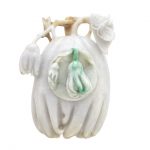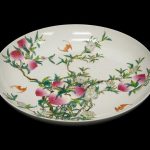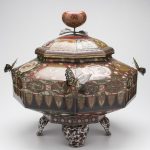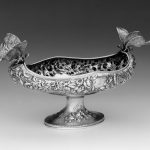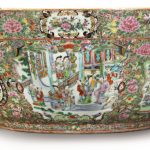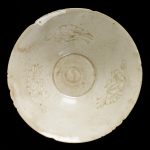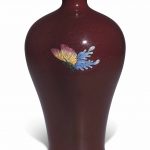Bowls. Some examples of bowls with butterflies in their design including an extremely rare painted Cizhou bowl from the Jin Dynasty and a cloisonne bowl.
A very unusual Nantgarw bowl, circa 1818-20 Of shallow form with C-scroll moulding picked out in gold, painted in London with a central peacock butterfly surrounded by scattered gilt sprigs, the border panels with brightly coloured feathers, 20.5cm diam, impressed NANT-GARW CW FOOTNOTES The peacock butterfly is accurately painted and must have been copied from a source print, or perhaps directly from life. Accurate representations of butterflies are only rarely found on British porcelain, mostly on Derby. Compare with the Nantgarw shell dish locally painted with butterflies by Thomas Pardoe with little attempt at realism and illustrated by W D John, Nantgarw Porcelain Album (1975), Illustration 78
Sold for £ 1,250 inc. premium at Bonhams in 2018
Bowl. Butterfly medallions. Made of famille rose enamelled ceramic, porcelain. Culture/period Yongzheng (reign) Qing Dynasty dynasty term details Date 1723-1735
© The Trustees of the British Museum
AN EXTREMELY RARE PAINTED CIZHOU DEEP BOWL JIN DYNASTY (1115-1234) The finely potted ovoid body is raised on a high foot ring and covered with a white slip painted in dark brown with six butterflies, their outstretched wings with combed details, all under a clear glaze that stops on the lower body to reveal the pale buff ware. 7 1/8 in. (18 cm.) high, Japanese wood box, silk pouch and lacquered cover
Sold for USD 137,500 at Christies in 2018
Chinese Jade Citron Form Covered Bowl Carved in high relief as the fruit borne on a leafy fruiting branch with a butterfly perched on one leaf, the stone a light gray-white with apple green, chestnut and lavender inclusions. Length 4 inches.
Sold for $687 (includes buyer’s premium) at Doyle New York in 2019
Chinese porcelain large bowl with peaches and butterfly decoration. Apocryphal Ming mark. (3 1/2 x 17 3/8 inches).
Sold for $190 at D.G.W. Auctioneers Inc. in 2019
Cloisonne octagonal vessel with lid with three detachable butterflies Made in Japan A Japanese cloisonne enamel bowl with cover. The bowl is octagonal in shape and stands on four bracket feet, which are decorated with panels featuring a unicorn, phoenix, turtle and dragon surrounded by flowers and foliage. Accompanying the bowl are three black and yellow butterflies and a decorative knob with foliage, which can be attached to the cover of the bowl.
Reference: Museum of Applied Art and Sciences
Footed bowl 1880–90 Samuel Kirk & Son (active 1846–1861, 1868–1896), Samuel Kirk (American, 1793–1872), Henry Child Kirk, Sr. (American, 1827–1914), Henry Child Kirk Jr. (American, joined firm in 1890)
The shallow, oval, raised bowl of the compote has an undulating rim with a rounded applied band and sits on a spool-type pedestal with a wide oval foot. Large butterflies of indeterminate species (possibly a swallowtail butterfly, family Papilionidae), with stamped details, perch upon the ends of the bowl. A dense band of repousséd and chased floral decoration circles the bowl, under the rim. Clusters of naturalistic flowers embellish the front and back of the engraved and punched ground of the elliptical foot with applied foot ring. This footed bowl still displays the deep relief characteristic of the Rococo-revival style, as seen in the encircling naturalistic band of flowers. However, the graphic outlines and flat interior markings of the butterfly’s wings seem to relate it to the newer, flatter forms and more stylized design popular during the last quarter of the nineteenth century. The sinuous line of the rim and elongated body suggest a natural pool of water that has attracted the two insects and may reflect an affinity for the Japanese aesthetic in vogue at the time. This text has been adapted from “Silver of the Americas, 1600-2000,” edited by Jeannine Falino and Gerald W.R. Ward, published in 2008 by the MFA. Complete references can be found in that publication.
Reference: Museum of Fine Arts Boston
A RARE AND MASSIVE CHINESE CANTON FAMILLE-ROSE ‘ROMANCE OF THE THREE KINGDOMS’ BOWL, 19TH CENTURY sturdily potted set on a straight short foot rising up to a slightly flaring rim, the exterior finely decorated allover with blossoms, fruits and butterflies, with two circular reserves painted with peonies issuing from rockwork, and four shaped reserve panels decorated with figures in garden pavilions, the interior painted with a continuous scene of characters from the Romance of the Three Kingdoms reserved on a bright yellow ground diameter 23 in.; 58.5 cm
Sold for 12,500 USD at Sothebys in 2019
Bowl of porcelain with decoration incised under a qingbai glaze. Conical with six notches in the rim. The inside is engraved with three butterflies, surrounding a central medallion containing a yin-yang symbol. Place of Origin Jingdezhen (made) Date 12th century (made)
Reference: © Victoria and Albert Museum




